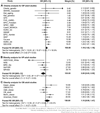Meta-analysis in clinical trials revisited
- PMID: 26343745
- PMCID: PMC4639420
- DOI: 10.1016/j.cct.2015.09.002
Meta-analysis in clinical trials revisited
Abstract
In this paper, we revisit a 1986 article we published in this Journal, Meta-Analysis in Clinical Trials, where we introduced a random-effects model to summarize the evidence about treatment efficacy from a number of related clinical trials. Because of its simplicity and ease of implementation, our approach has been widely used (with more than 12,000 citations to date) and the "DerSimonian and Laird method" is now often referred to as the 'standard approach' or a 'popular' method for meta-analysis in medical and clinical research. The method is especially useful for providing an overall effect estimate and for characterizing the heterogeneity of effects across a series of studies. Here, we review the background that led to the original 1986 article, briefly describe the random-effects approach for meta-analysis, explore its use in various settings and trends over time and recommend a refinement to the method using a robust variance estimator for testing overall effect. We conclude with a discussion of repurposing the method for Big Data meta-analysis and Genome Wide Association Studies for studying the importance of genetic variants in complex diseases.
Keywords: Big Data; Clinical trials; Genome Wide Association Studies; Heterogeneity; Meta-analysis; Random-effects model.
Published by Elsevier Inc.
Figures
References
-
- DerSimonian R, Laird NM. Meta-analysis in clinical trials. Controlled Clinical Trials. 1986;7:177–188. - PubMed
-
- Glass GV. Primary, secondary, and meta-analysis of research. Educational Researcher. 1976;5:3–8.
-
- Rosenthal R, Rubin DB. Interpersonal expectancy effects: The first 345 studies. Behavioral and Brain Sciences. 1978;1:377–386.
-
- Mosteller F. The Tennessee Study of Class Size in the Early School Grades. The Future of Children. 1995;5(2):113–127. - PubMed
-
- Mosteller F, Light RJ, Sachs JA. Sustaining Inquiry in Education: Lessons from Skill Grouping and Class Size. Harvard Educational Review. 1996;66(4):797–842.
MeSH terms
Grants and funding
LinkOut - more resources
Full Text Sources
Other Literature Sources
Medical









